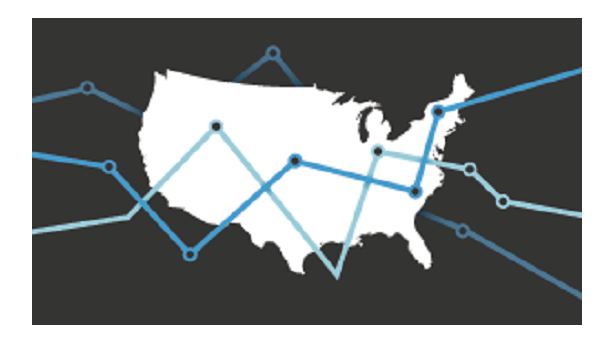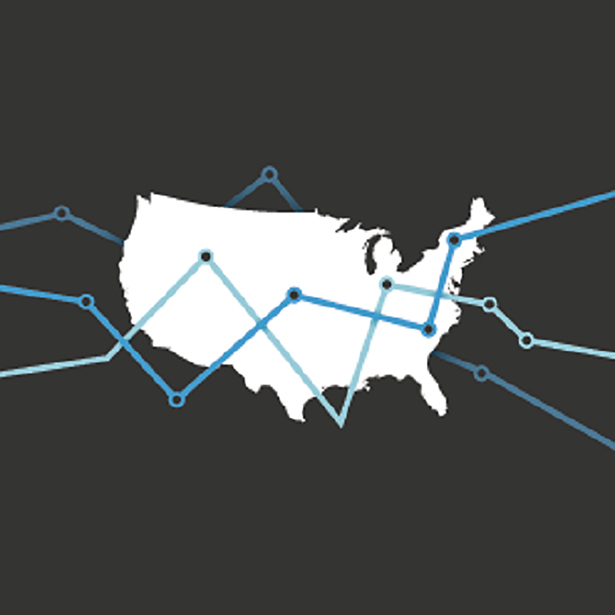Tax Revenue Swings Complicate State Budgeting
Note: This data has been updated. To see the most recent data and analysis, visit Fiscal 50.
The coronavirus pandemic is causing sharp, unpredictable swings in tax collections, confounding state lawmakers’ efforts to balance budgets. Sudden fluctuations present challenges even under less extreme economic conditions—with some states experiencing far higher levels of tax revenue volatility than others, depending on their tax mix. Over the past two decades, year-to-year fluctuations have been greatest in natural resource-dependent economies, driven by the boom and bust cycle of energy prices.
Revenue volatility differs across states because each relies on a unique mix of tax streams. Individual tax streams experience different fluctuations from year to year, contributing to a state’s overall revenue volatility. Between fiscal years 2000 and 2019, severance taxes on oil and minerals and corporate income taxes were consistently more volatile than other major state taxes, such as those on personal income and sales of goods and services.
Although states can raise or lower tax revenue by changing tax policies, the underlying volatility of individual tax streams is often driven by a variety of factors, many outside policymakers’ control. These include economic factors—such as the mix of industry, natural resources, workforce, and population growth—as well as changes to federal budget and tax policy and unforeseen events, such as the coronavirus pandemic.
In 2020, for example, no major tax revenue sources were left unscathed as the pandemic brought an abrupt end to the longest economic expansion in U.S. history. Even sources that are relatively less volatile, such as broad-based personal income taxes on wages and investment earnings, have been battered by unemployment rates that spiked early this year and remain high along with historic stock market volatility. General sales tax revenue—usually one of the most stable tax streams for states—also steeply declined as restaurants, bars, retail stores, and other businesses were shuttered and as consumer spending fell sharply. The pandemic’s effects are the most recent example of tax revenue volatility, but 2020 data was not yet available to include in this assessment of each state’s long-term trends.
In this analysis, The Pew Charitable Trusts removes the estimated effect of state tax policy changes, which state lawmakers control, to calculate a volatility score for the underlying trends in each state’s overall tax revenue and major taxes—those that account for at least 5% of its tax revenue on average over the past decade.
The scores measure the variation in year-over-year percent changes between fiscal 2000 and 2019, based on a calculation of standard deviation. A low score means that revenue levels were similar from year to year, and a high score indicates that revenue grew or declined more dramatically.
Overall, 50-state tax revenue had a volatility score of 4.96 for the 20 years ending in fiscal 2019, slightly lower than the previous year of 5.01. This means that total tax revenue across the states typically fluctuated 4.96 percentage points above or below its overall growth trend. Tax revenue was more volatile than the national benchmark in 29 states and less so in 21.
Source: Volatility scores for each state’s overall tax revenue and specific tax sources were calculated using the U.S. Census Bureau’s State Government Tax Collections historical data series from fiscal 1999 to 2019. Data were adjusted to control for the effects of tax policy changes using the National Conference of State Legislatures’ State Tax Actions reports for fiscal 1999 to 2019.
State highlights
- The highest volatility occurred in Alaska (36.9 percentage points), North Dakota (16.4), and Wyoming (13.3), all natural resource-dependent economies that rely heavily on severance tax revenue.
- The lowest volatility occurred in three states: South Dakota (2.7), Arkansas (2.9), and Kentucky (2.9). Each of these states relies on relatively stable tax streams for over half of its revenue—sales for South Dakota, and sales and personal income for Arkansas and Kentucky.
- Volatility scores rose in 24 states for the 20-year period through fiscal 2019, compared with scores based on the period from fiscal 1999 to 2018, though many of the increases were small enough to be obscured by rounding. New Mexico and Utah experienced the greatest increases. New Mexico’s increase was driven by an upswing in severance and sales taxes, and Utah’s by growth in personal income and sales taxes.
- Severance tax, which is highly dependent on global energy prices, was the most volatile revenue source in eight of the nine states where it accounted for enough revenue over the past decade to be considered a major tax. The exception was Alaska, where corporate income tax revenue was most volatile. Volatility scores for severance tax ranged from 18.9 in Louisiana to 47.0 in Alaska.
- Corporate income tax revenue seesawed more than any other tax stream in 17 of the 20 states where it was a major tax. Volatility scores for this tax ranged from 13.0 in Tennessee to 53.7 in Alaska.
- Broad-based personal income tax, collected in 41 states, and sales tax, collected in 45 states, were relatively less volatile revenue sources. Volatility scores ranged from 4.6 in West Virginia to 16.5 in North Dakota for personal income tax, and from 2.8 in Wisconsin to 14.5 in North Dakota for sales tax.
In general, two factors work in tandem to influence a state’s overall revenue volatility: how dramatically each tax stream changes from year to year and how heavily a state relies on each revenue source. Smaller tax streams can be highly volatile. But the more minor the tax source, the less of an impact it has on a state’s overall revenue volatility.
For example, the three states with the highest overall scores—energy-rich Alaska, North Dakota, and Wyoming—collected the greatest share of their tax dollars over the past 10 years from highly volatile severance taxes. Yet Texas, the largest oil producer in the nation, ranked close to the middle of states for overall revenue volatility even though its severance tax revenue was more volatile than any but Alaska’s. The crucial difference is that severance tax accounted for 7.5% of Texas’ total tax collections over the past decade, compared with 62.3% of tax revenue in Alaska, 45.7% in North Dakota, and 35.6% in Wyoming.
Similarly, in the 20 states where corporate income tax was a major source of tax revenue, it was the most volatile major source in 17. However, its average share of total tax revenue was under 10% in 17 of these states.
Changes to federal budget and tax policy are among the factors that can affect the underlying volatility of state tax streams. In 2018, states experienced their largest annual swing in tax collections since the depths of the Great Recession in 2009, as collections climbed and states and taxpayers began adjusting to passage of the federal Tax Cuts and Jobs Act (TCJA). Because of the way in which state and federal tax codes are linked, the TCJA’s federal tax code changes automatically led to higher state tax bills for some residents and businesses, unless states counteracted them. Despite this upswing, the overall revenue volatility score for the 20-year period through fiscal 2019 did not shift in most states.
Although volatility complicates the already difficult tasks of revenue forecasting and budgeting, it is not inherently bad. When receipts are higher than anticipated, states can pay down debt, make one-time investments such as in infrastructure projects, or build up reserves. But periods of unexpectedly high revenue may just as easily be followed by years of unanticipated low revenue that may prompt spending cuts, tax increases, or withdrawals from dedicated savings accounts to make ends meet.
By studying volatility, policymakers can better determine their own budgetary risk and put in place evidence-based savings strategies that harness tax growth in good years to cushion the lean years. These strategies include depositing one-time or above-average revenue into a rainy day fund and dedicating these balances to explicit, narrowly defined spending purposes. States can also reduce fiscal uncertainty by restricting spending from particularly volatile tax streams. Revenue from these streams could instead be deposited in longer-term savings accounts or sovereign wealth funds, as several natural resource-rich states do. These policies can help stabilize budgets and aid policymakers in planning for the long term.
Download the data to see individual state trends. Visit Pew’s interactive resource Fiscal 50: State Trends and Analysis to sort and analyze data for other indicators of state fiscal health.








